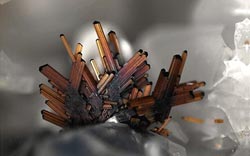A tiny grain helps reveal the history of a rock

Photograph of rutile.<br>Photographer: Fred Kruijen<br>
Rutile is used in ceramics and paints, but is particularly useful for finding out about the history of a rock.
Where mineral deposits are found, rutile is often also present. The new methods therefore bring opportunities for strategies to find other mineral deposits, such as gold.
Until now, rutile has been a relatively unknown mineral, despite not being rare. For example, rutile can be found on most sandy beaches around the world, including in Sweden.
“It’s incredible to see how little attention was paid to rutile until around five years ago,” says geologist and researcher Thomas Zack, from the University of Gothenburg’s Department of Earth Sciences, who has devoted much of his scientific career to studying the mineral.
Now, geologists can identify rock types containing rutile and follow the changes in temperature and pressure that they have been exposed to throughout its history, even if rutile is barely visible to the naked eye. Previously, researchers had to investigate considerably more rutile-bearing samples in order to carry out analyses.
“But now we can identify the rock from which the rutile originates, even if we only have a tiny grain of rutile,” adds Thomas Zack.
New method produces fast results
The new method is called “Laser Ablation ICP-MS”, and produces results much faster than previous methods.
“In analytical terms, this is one of the most important analytical instruments at the Department of Earth Sciences here in Gothenburg,” concludes Thomas Zack.
Contact: Thomas Zack, Senior Lecturer
Department of Earth Sciences, telephone: +46 (0)31 786 2
e-mail: thomas.zack@gvc.gu.se
Media Contact
More Information:
http://www.gu.seAll latest news from the category: Earth Sciences
Earth Sciences (also referred to as Geosciences), which deals with basic issues surrounding our planet, plays a vital role in the area of energy and raw materials supply.
Earth Sciences comprises subjects such as geology, geography, geological informatics, paleontology, mineralogy, petrography, crystallography, geophysics, geodesy, glaciology, cartography, photogrammetry, meteorology and seismology, early-warning systems, earthquake research and polar research.
Newest articles

A universal framework for spatial biology
SpatialData is a freely accessible tool to unify and integrate data from different omics technologies accounting for spatial information, which can provide holistic insights into health and disease. Biological processes…

How complex biological processes arise
A $20 million grant from the U.S. National Science Foundation (NSF) will support the establishment and operation of the National Synthesis Center for Emergence in the Molecular and Cellular Sciences (NCEMS) at…

Airborne single-photon lidar system achieves high-resolution 3D imaging
Compact, low-power system opens doors for photon-efficient drone and satellite-based environmental monitoring and mapping. Researchers have developed a compact and lightweight single-photon airborne lidar system that can acquire high-resolution 3D…





















